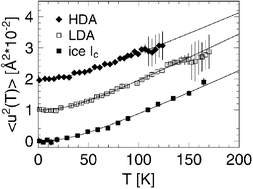High-resolution neutron backscattering techniques are exploited to study the elastic and quasi-elastic response of the high-density amorphous (HDA), the low-density amorphous (LDA) and the crystalline ice Ic upon temperature changes. Within the temperature ranges of their structural stability (HDA at T
≤ 80 K, LDA at T
≤ 135 K, ice Ic at T
≤ 200 K) the Debye–Waller factors and mean-square displacements characterise all states as harmonic solids. During the transformations HDA→LDA (T
≈ 100 K), LDA→Ic
(T
≈ 150 K) and the supposed glass transition with Tg
≈ 135 K no relaxation processes can be detected on a time scale t < 4 ns. It can be concluded from coherent scattering measurements (D2O) that LDA starts to recrystallise into ice Ic at T
≈ 135 K, i.e. at the supposed Tg. In the framework of the Debye model of harmonic solids HDA reveals the highest Debye temperature among the studied ice phases, which is in full agreement with the lowest Debye level in the generalised density of states derived from time-of-flight neutron scattering experiments. The elastic results at low T indicate the presence of an excess of modes in HDA, which do not obey the Bose statistics.

You have access to this article
 Please wait while we load your content...
Something went wrong. Try again?
Please wait while we load your content...
Something went wrong. Try again?


 Please wait while we load your content...
Please wait while we load your content...